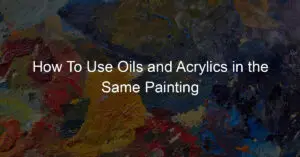As a painter, I like to be a good and almost annoying creature when it comes to selecting my gear in general.
Still, when selecting the right pigment, I’m doing it carefully because it is an important part of creating a successful painting.
In this article, we’ll discuss how to choose the right pigment for your painting and the benefits of doing so.
The Introduction to Imprimatura
Imprimatur is a painting technique used by artists to prepare the canvas for painting.
It involves adding a thin, transparent layer of paint to the canvas before beginning the painting. This layer of paint creates a uniform surface and helps protect the canvas from the elements.
It also helps to create a basecoat for the painting and can be used to add depth and texture to the painting.
Imprimatur is typically made up of two parts: pigment and a binder. The pigment is what gives the layer of paint its color and opacity. The binder is what binds the pigment to the canvas and keeps it in place.
A good quality pigment is essential for creating a successful painting. Choosing the right pigment for your painting is an important part of the process and can make all the difference in the final result.
Understanding the Basics of Pigments
Pigments are substances that give the paint its color and opacity. They are usually made of natural or synthetic materials, such as minerals, vegetable dyes, and synthetic dyes.
Each pigment has its unique properties that affect how it reacts with other pigments and how it will look on the canvas.
It’s important to understand the basics of pigments to make the right choice for your painting.
The most important thing to consider when choosing a pigment is its lightfastness.
Lightfastness refers to how well a pigment can withstand sunlight or other forms of light.
Pigments that are not lightfast will fade or change color when exposed to light. Lightfast pigments can withstand exposure to light without fading or changing color.
In addition to lightfastness, it’s important to consider the opacity and tinting strength of a pigment. Opacity refers to how much of the light that hits the pigment is reflected.
Tinting strength refers to how much of a color a pigment can produce. Pigments with a higher opacity and tinting strength will produce brighter and more vibrant colors.
Choosing the Right Pigment for Your Painting
Now that you understand the basics of pigments, it’s time to talk about how to choose the suitable correct pigment for your painting.
There are a few factors to consider when selecting a pigment for your painting. The first is the type of pigment.
Natural pigments are derived from natural sources such as plants, minerals, and animals. Synthetic pigments are made using chemical processes.
The second factor to consider is the color of the pigment. Pigments come in a variety of colors, from bright and vibrant to muted and subtle.
It’s important to choose a color that will complement the painting and bring out the desired effect. The third factor to consider is the lightfastness of the pigment.
A fun fact about Pigments for Imprimatura is that certain pigments, such as certain organic pigments, are made up of complex molecular structures that make them resistant to light and other environmental factors.
This means that the colors of paint you use won’t fade over time when exposed to sunlight or other elements.
In particular, organic pigments tend to be the most lightfast and durable choice for Imprimatur.
As I have mentioned earlier (and in my other posts), lightfastness refers to how well a pigment can withstand light. Pigments that are not lightfast will fade or change color when exposed to light.
It’s crucial to choose a pigment that is lightfast so your painting will last for years to come. (Right choice leads to perfection, slowly but surely).
The fourth factor to consider is the opacity and tinting strength of the pigment.
Pigments with a higher opacity and tinting strength will create brighter and more vibrant colors. On the other hand, pigments with a lower opacity and tinting strength will create more muted and subtle colors.
The Difference Between Natural and Synthetic Pigments
When creating art, it’s important to recognize the distinction between organic and synthetic pigments.
Organic colors are derived from sources like plants, minerals, or animals while artificial hues are formulated with chemical mixtures.
Natural pigments tend to be more vibrant and have a higher lightfastness than synthetic pigments.
However, they can be harder to find and more expensive. Synthetic pigments are more readily available and usually less expensive than natural ones.
However, they tend to have a lower lightfastness and may not be as vibrant as natural pigments.
Factors to Consider When Choosing a Pigment
When you are selecting a pigment for your great painting, there are a few factors to consider.
The first is the type of pigment. As mentioned earlier, pigments come in both natural and synthetic varieties. The second is the color of the pigment.
Choosing a color that perfectly accents the painting and will bring out its intended effect is essential.
Moreover, it’s critical to consider the longevity of the pigment you select since lightfastness can be an issue.
It’s important (well, of course) to choose a pigment that is light-fast so your painting will last for years to come. The fourth is the opacity and tinting strength of the pigment.
Remember: Pigments with a higher opacity and tinting strength will create brighter and more vibrant colors.
Tips and Tricks for Choosing the Right Pigment
Now that you understand the basics of pigment selection, here are some tips and tricks to help you choose the suitable pigment for your painting.
The first tip is to test the pigment before you use it. This will help you get a better idea of how the pigment will look on the canvas and how it will interact with other pigments.
The second tip is to use a color wheel to help you choose the right colors for your painting. A color wheel can help you visualize how colors will look together and make it easier to choose complementary colors.
The third tip is to experiment with different pigments to see which ones work best for your painting.
Different pigments will have different properties, and it’s important to experiment to find the right one for your painting.
The fourth tip is to keep a journal of your experiments. Writing down your experiments will help you remember which pigments worked best and why. This will save you time and energy in the long run.
Common Pigments Used in Imprimatura
Now that you are familiar with how to pick the ideal pigment for your artwork, allow us to explore some of the most commonly used pigments in imprimatur.
The most popular pigments in imprimatur are titanium dioxide, iron oxide, and carbon black. Titanium dioxide is a very popular and light-fast pigment that is used to create bright whites and vibrant colors.
Iron oxide is a lightfast pigment that is used to create muted and subtle colors. Carbon black is a lightfast pigment that is used to create deep, dark colors.
The Benefits of Choosing the Right Pigment
The first obvious benefit is that it will help protect your painting from fading and discoloration due to light exposure.
Lightfast pigments will be less likely to fade or change color when exposed to light.
The second great benefit is that it will create a more vibrant and vivid painting (everybody wants that).
Pigments with a higher opacity and tinting strength will create brighter and more vibrant colors. On the other hand, pigments with a lower opacity and tinting strength will create more muted and subtle colors.
The third (and not least actually) benefit is that it will save you time and energy in the long run.
Experimenting with different pigments can be time-consuming. Choosing the right pigment from the start will save you time and energy in the long run.
Conclusion
When creating your masterpiece, selecting the ideal pigment is key to its success.
Make sure to choose one with superior lightfastness, opacity, and tinting strength; this will ensure that your painting retains vibrancy over time.
Natural pigments tend to be more vibrant and have a higher lightfastness than synthetic pigments.
However, they can be harder to find and more expensive. Synthetic pigments are more readily available and usually less expensive than natural ones.
It’s important to understand the basics of pigments and experiment with different dyes to find the right one for your painting.
Keeping a journal of your experiments can help you remember which pigments worked best and why. This will save you time and energy in the long run.
By following these tips and tricks, you can be sure to choose the right pigment for your painting and create a successful painting that will last for years to come.
How To Choose a Pigment for Imprimatura? This article has provided you with an expert guide on how to choose the right pigment for your painting.
By understanding the basics of pigments, considering the factors to consider when choosing a pigment, and following some troubleshooting tips, you can be sure to choose the right pigment for your painting.


















